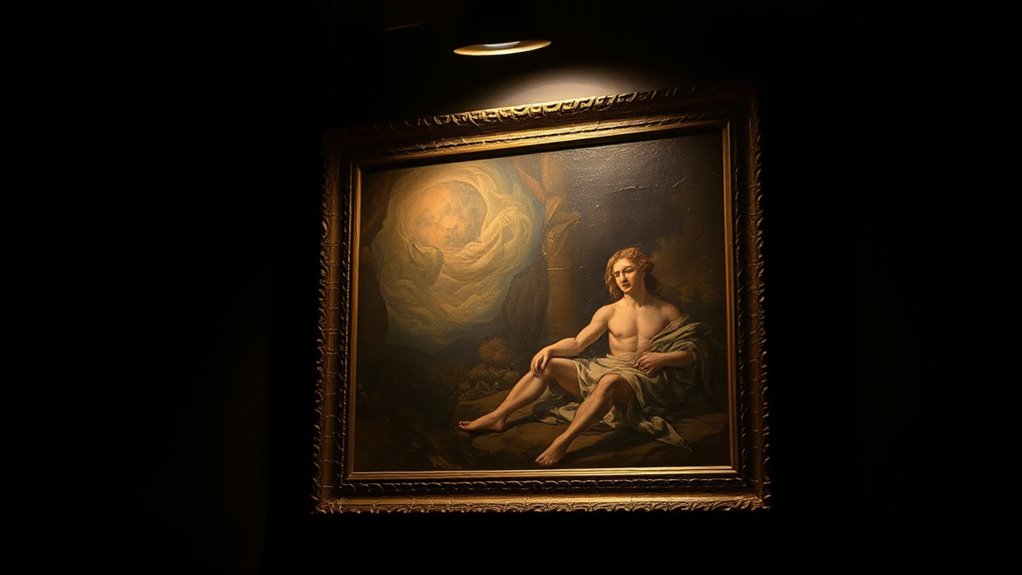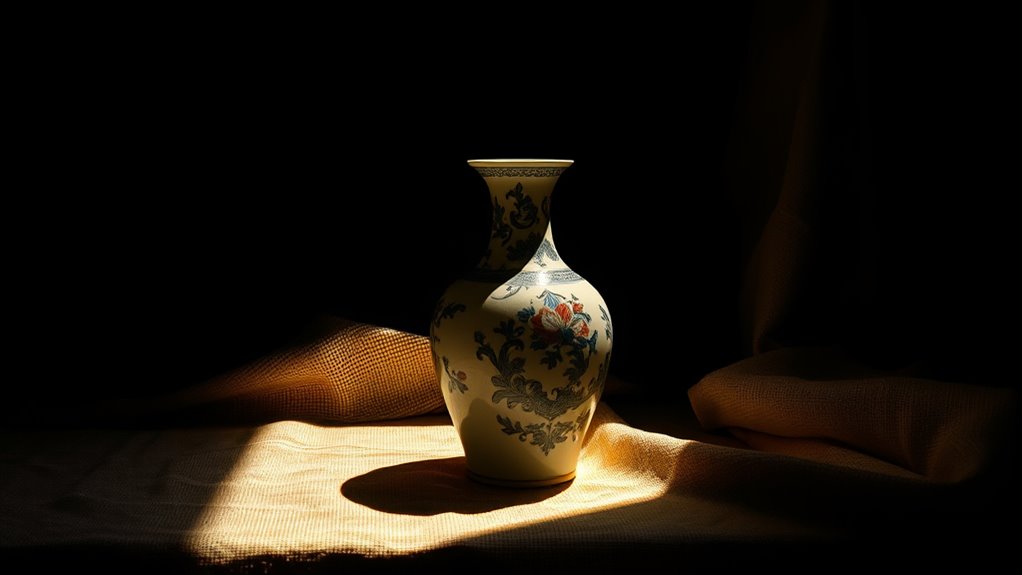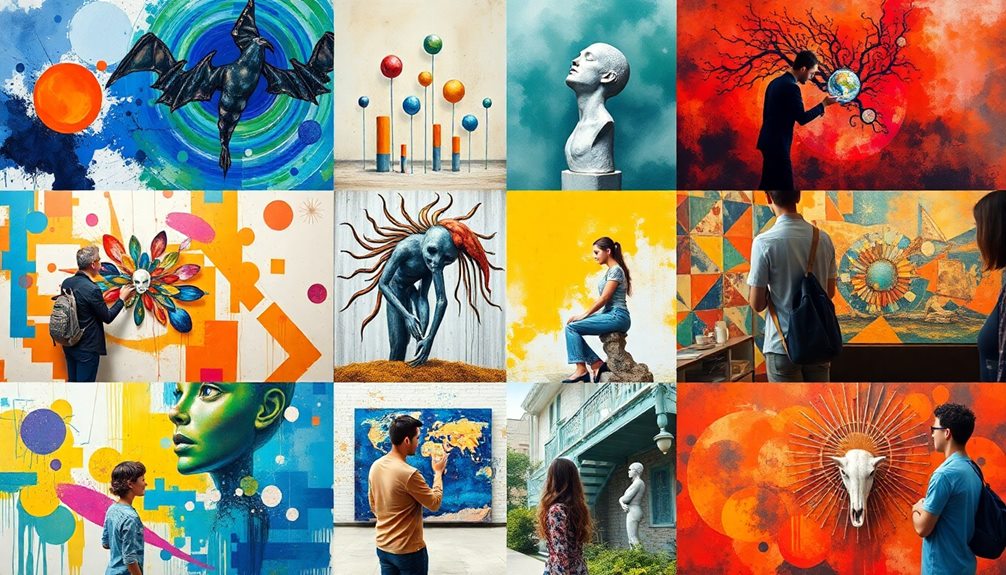Chiaroscuro is a technique in art that plays with light and shadow to create depth, realism, and drama. It highlights contrasts, emphasizing certain areas while pushing others into darkness, which directs the viewer’s focus and evokes emotion. Originating during the Renaissance and perfected by artists like Caravaggio, it has shaped how artists craft mood and volume in their work. Exploring its history further will help you understand how this powerful tool can elevate your artistic expression.
Key Takeaways
- Chiaroscuro is an artistic technique that uses contrasting light and shadow to add depth and realism.
- It originated during the Renaissance, notably used by Leonardo da Vinci and Michelangelo.
- Baroque artists like Caravaggio employed stark contrasts to evoke emotional intensity.
- The technique enhances three-dimensionality, guiding viewers’ focus and emphasizing mood or drama.
- Modern technology expands possibilities for manipulating light and shadow, continuing its influence in contemporary art.

Chiaroscuro is a fundamental technique in art that creates striking contrasts between light and shadow, giving depth and volume to a composition. When you master this technique, you can dramatically influence how viewers perceive your work, emphasizing mood, emotion, and realism. The dramatic effects achieved through chiaroscuro draw attention to focal points and add a sense of three-dimensionality that makes your artwork come alive. Historically, the development of chiaroscuro traces back to the Renaissance, where artists like Leonardo da Vinci and Michelangelo began exploring how to manipulate light and shadow to enhance realism. During this period, artists sought to imitate the way natural light interacts with objects, moving away from flatter, more decorative styles. The Renaissance marked a pivotal point in the historical development of chiaroscuro, as it became a key tool for creating convincing volume and depth in two-dimensional art.
As you explore more deeply into its history, you’ll find that chiaroscuro’s influence extended into Baroque art, where it was used to heighten emotional intensity. Artists like Caravaggio took the technique to new levels, employing stark contrasts and deep shadows to produce dramatic effects that evoke tension and drama. These bold contrasts help you direct the viewer’s eye and evoke powerful emotional responses. The evolution of chiaroscuro didn’t stop there; it also influenced other media, including printmaking and later, photography, where the manipulation of light and shadow continues to be essential. Moreover, understanding the historical development of chiaroscuro can enhance your ability to apply it effectively in contemporary art practices. Recognizing the artistic evolution of techniques like chiaroscuro allows you to appreciate their role in shaping visual storytelling throughout history. Studying the historical context of chiaroscuro can deepen your comprehension of its purpose and inspire more intentional application in your own work. Additionally, exploring the cultural impact of chiaroscuro reveals how it influenced artistic expression beyond just technique, shaping visual narratives across different eras. Learning about how technological advances have expanded the possibilities of light and shadow manipulation can also inform your creative approach. Understanding the historical development of chiaroscuro enables you to appreciate how artists have used it to serve different artistic goals over time. From the delicate gradations of light in Leonardo’s sketches to the intense chiaroscuro in Baroque paintings, this technique has evolved as a means to heighten realism, dramatize scenes, and evoke mood. When you incorporate chiaroscuro into your work, you’re not just applying a stylistic element—you’re participating in a long tradition of visual storytelling that has shaped art for centuries. By studying its historical development, you can better understand its purpose and potential, allowing you to employ it more effectively to create compelling, emotionally resonant images. Whether you’re aiming for subtle realism or dramatic impact, grasping how chiaroscuro has been developed over time helps you harness its power to achieve your artistic vision.
Frequently Asked Questions
How Did Chiaroscuro Originate Historically in Art?
You might wonder how chiaroscuro originated historically in art. In the historical context, artists began experimenting with light and shadow to create depth and realism. This technique evolved during the Renaissance as artists like Leonardo da Vinci and Caravaggio mastered the artistic evolution of contrasting tones. They used chiaroscuro to add drama and volume, transforming flat images into lifelike scenes that captivate viewers and deepen the emotional impact of their work.
What Are the Key Differences Between Chiaroscuro and Tenebrism?
Think of chiaroscuro as a gentle dance of light contrast and shadow manipulation, soft and subtle. Tenebrism, on the other hand, is more like a spotlight blindingly piercing darkness, with dramatic intensity. The key difference lies in their approach: chiaroscuro uses gradual shading for depth, while tenebrism employs stark contrasts to create a sense of mystery and focus. You’ll notice tenebrism’s boldness, whereas chiaroscuro offers a nuanced, balanced glow.
Which Famous Artists Are Renowned for Their Use of Chiaroscuro?
You’ll find that Caravaggio’s mastery of chiaroscuro creates dramatic contrasts that draw your eye, emphasizing emotion and realism. Rembrandt’s use of chiaroscuro adds depth and texture, making his scenes feel intimate and powerful. Both artists use light and shadow brilliantly, guiding your focus and evoking mood. Their works showcase how chiaroscuro can elevate storytelling, making their art timeless and influential in the world of fine art.
How Does Chiaroscuro Influence Modern Digital Art Techniques?
Imagine a digital canvas where shadows whisper and highlights glow, creating depth like a shadowed forest. Chiaroscuro influences modern digital art by guiding your use of digital shading and highlight blending, giving your work a realistic, three-dimensional feel. You can craft dramatic contrasts and subtle gradations, making your images more vivid and compelling. Embracing this technique enhances how you manipulate light and shadow, elevating your digital creations with timeless artistic principles.
Can Chiaroscuro Be Effectively Used in Abstract Art?
You can effectively use chiaroscuro in abstract art by emphasizing abstract expression and color contrast. By playing with light and shadow, you create depth and focus that guide viewers through your piece. Even in non-representational work, this technique adds drama and emotional intensity. Use bold contrasts to highlight key areas, making your abstract art more dynamic and engaging, leveraging chiaroscuro’s power to evoke mood and movement.
Conclusion
Now that you understand chiaroscuro, you can see how artists like Caravaggio used light and shadow to evoke emotion and depth. It’s like your favorite playlist, where contrasts create the mood. Remember, mastering this technique isn’t about the latest AI filters but about honing your eye, much like tuning an old vinyl. As you experiment, you’ll discover that chiaroscuro remains timeless—proof that true artistry transcends every era, even the age of social media.









